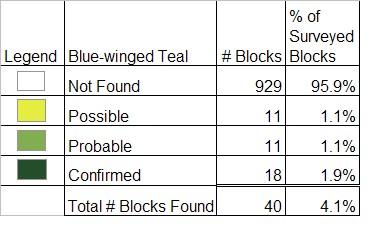Breeding Bird Atlases (BBA)
Find a Bird - BBA1
Breeding Bird Atlas 1 Species Accounts
Blue-winged Teal
Anas discors
Egg Dates
May 4 to late July
Number of Broods
one; may re-lay if first attempt fails.

This small teal characteristically is a breeding bird of the shallow marshes and sloughs of central North America, but it also nests in suitable wetlands to the east from the Maritime Provinces to coastal salt marsh ponds in North Carolina. In Massachusetts, most nesting records in recent years have been from coastal marshes of Essex County or in the Sudbury-Concord River valley, but there have been scattered reports of suspected or confirmed breeding throughout the state, including the ponds on Monomoy Island.
Despite its tame and confiding nature, the Blue-winged Teal remains one of the most abundant of dabbling ducks in North America. The relative success of this species, even in the face of diminishing wetland habitat, has been due both to its ability to breed on small wetlands and to its early autumn migration. It is one of the first duck species to depart in the fall, passing through Florida by early September and thus avoiding most of the hunting season in the United States.
Blue-winged Teal become plentiful during spring migration. Pair formation takes place during this time or on the wintering grounds. It may be late April before pairs reach their breeding grounds, after most other species of ducks have initiated nesting. They select aquatic territories, which the drakes aggressively defend against conspecifics.
During this activity, the normally quiet birds become quite noisy. Males utter excited peeping notes, and the females have a low quack, most frequently given when the nest or brood is disturbed. Hens seek suitable nesting cover, usually areas of low grass or sedge near water but sometimes a distance from it. One egg is laid daily until a clutch of eleven or twelve is reached. Incubation takes 23 to 24 days. Many nests are destroyed by predators. When that happens, renesting usually occurs, but the clutches are smaller. Only one brood is raised annually. As with other ducks, hens do all the incubating and brood rearing. The females lead the ducklings to shallow wetlands with an abundance of emergent vegetation, where they fledge in about six weeks. Five Massachusetts brood dates range from May 29 to August 14, with eight as the most commonly reported number of ducklings.
Drakes leave their mates before the eggs hatch and usually gather in small groups. They gradually molt into an eclipse plumage in which they closely resemble the females. All flight feathers are replaced during a three-week period. Blue-winged Teal retain this plumage longer than most other ducks, and many drakes do not attain full nuptial plumage until late winter.
The food of this species consists primarily of duckweed and the vegetative parts of aquatic plants and seeds of various sedges, grasses, smartweed, and other wetland plants. In summer larger amounts of insects and mollusks are consumed. Young ducklings feed almost entirely on small invertebrates. Most Blue-winged Teal leave the state in early fall, when numbers are once again swelled by migrants. Probably less than 10 percent of the continental population winters in marshes along the South Atlantic and Gulf coasts. Many individuals continue to northern South America. Winter birds are very rare this far north.
Map Legend and Data Summary
Atlas 1 data collected from 1975-1979


Note: uncommon and local in eastern marshes and refuge impoundments; rare in central and western areas
Ralph Andrews



